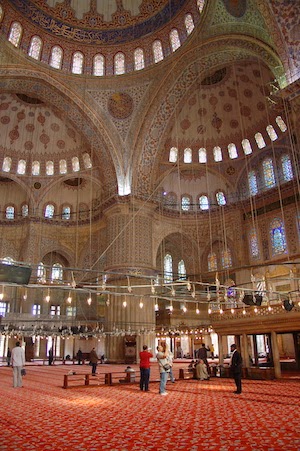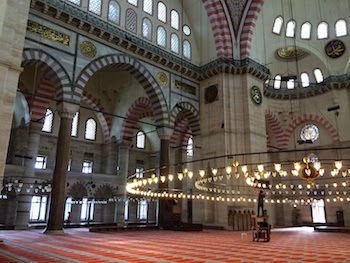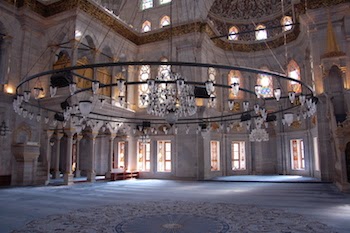 |
| The Nuruosmaniye Mosque |
Once we got to Istanbul, it took us a few days to go into a mosque. It wasn’t for lack of opportunity: it seems there are as many mosques in Istanbul as there are churches in Rome. We had never set foot in a mosque before, and the abundance of respect we seem to have for sacred spaces (which we blogged about yesterday) worked against us. We ruled out Fridays because it’s the Muslim day of prayer, and our first Thursday in the city we bought 3-day museum passes that had to be used before they expired, so it was Monday before this empty nest travel blog couple visited our first mosque.
Any trepidation we might have had quickly faded. We found the attendants entirely pleasant, affable, and helpful. Now–like we pointed out yesterday–if only all the visitors were actually respectful. We visited three of Istanbul’s top “destination” mosques plus a few others. Here’s a quick account of the three mosques in the order we visited them, but if you get to Istanbul be sure to include visits to a few of the smaller mosques too.
The Nuruosmaniye Mosque
(Picture at the top of this blog)
The Nuruosmaniye Mosque was a great first mosque experience for us. It is just to the east end of the Grand Bazaar, so if you visit that Istanbul landmark (and you certainly will) then this beautiful mosque offers a great break from the hustle and bustle of the bazaar. Despite being so close to the throngs of the bazaar, few tourists troop through this mosque, so it manages to retain a quiet, peaceful air.
Sultan Mahmut I ordered its construction in 1748, and it was completed in just 7 years. It has a unique columned half-circle courtyard and two minarets. Mosques are carpeted, and the color and style of the carpet gives the whole space–despite the grandeur of the structure or its decoration–its primary “feel”. The Nuruosmaniye’s carpet is a pastel blue, and it’s wonderfully set off by the white marble and gold-accented walls. The light shining through the windows makes the lampshades in the chandeliers sparkle magically. The Nuruosmaniye Mosque was Lori’s favorite.
The Sultan Ahmed Mosque (nicknamed the “Blue Mosque”)
 |
| The Massive Columns of the Blue Mosque |
We, like many other travel bloggers, would like to propose that the nickname of the Blue Mosque be changed to the Red Mosque. There is, in fact, very little of anything blue in this grand mosque, except a single row of blue tiles around the main dome’s interior and perhaps a very light blue tint to the exterior stone. We had passed by this mosque several times by the time we actually visited. Sitting at one end of Istanbul’s “tourist zone”, it attracts massive crowds. We saw lines stretching around two sides of the building, through its garden, and out through the Hippodrome and across the street: rumors had the wait time at three hours. If that were true, we’d likely never set foot in Istanbul’s most famous mosque.
But the cruise ships require their passengers back on board around 4pm, so 5pm is a great time to visit. We hadn’t planned to visit the afternoon we did, but on our way back to our hotel we noticed there was no line. None. So we went in.
 |
| The Blue Mosque, with a Tiny Bit of Actual Blue Around the Dome Above |
The Blue Mosque was built by its namesake, Sultan Ahmed I, and completed in 1616 (the neighborhood called Sultanahmet derives from Sultan Ahmed also). It’s a huge space set off by six minarets. Legend has it that the Sultan told his architect he wanted gold minarets, but the Turkish word for gold is very similar to the word six. Having an accidental half-dozen minarets might be almost as impressive as having gold minarets.
Even though we didn’t have to wait 3 hours to get in, the Blue Mosque was still a busy place, packed with the few fortunate tourists like us who came at the right time. It wasn’t our favorite of the three mosques, but it was still well worth the visit.
The Süleymaniye Mosque
 |
| The Süleymaniye Mosque |
The Süleymaniye Mosque is actually the largest mosque in Istanbul. It was commissioned by Sultan Süleyman (known to the world as Süleyman the Magnificent), designed by the prolific and famous architect Sinan, and built in only eight years between 1550 and 1558: when the Ottomans decided to build a mosque, they didn’t mess around.
 |
| Inside the Süleymaniye Mosque |
Sinan designed the mosque with predominantly red decorations which are accented to this day with brilliant red carpet. The space is grand, and being a less-trafficked mosque, it’s serene. When we visited, the sun was more directly overhead–not shining directly through any of the windows–which meant that illumination came primarily from the splendid chandelier (which was fully lit as workers replaced bulbs). This was Chuck’s favorite of the three big mosques we saw.
At the back of the Süleymaniye Mosque were great informational posters about Islam. Reading them, we were reminded that Muslims–like Jews and Christians–are also the faith descendants of Abraham. It was particularly interesting to read about their views on Jesus: did you know that while they don’t believe that Jesus was divine, they do believe He was the Messiah?







